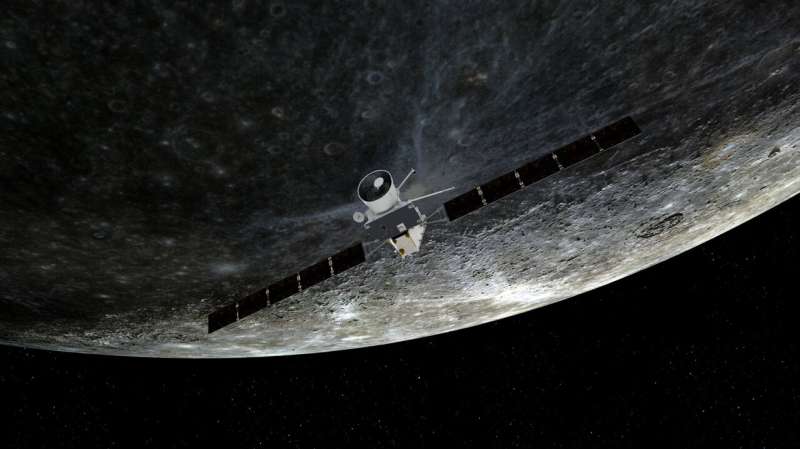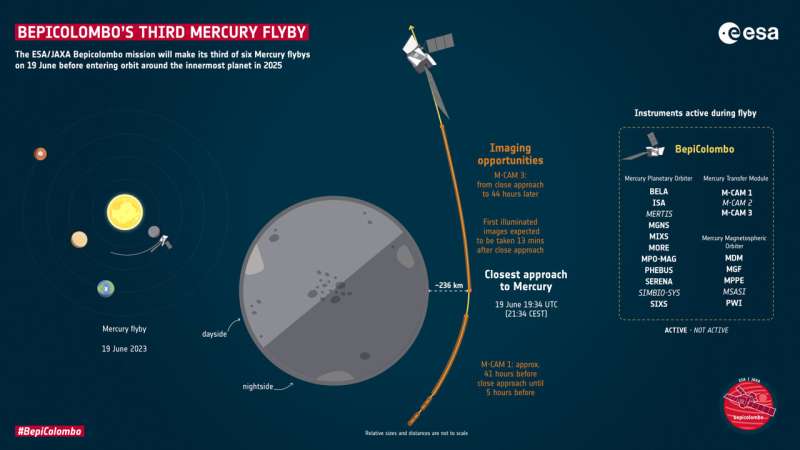This article has been reviewed according to Science X's editorial process and policies. Editors have highlighted the following attributes while ensuring the content's credibility:
fact-checked
trusted source
proofread
BepiColombo braces for third Mercury flyby

The ESA/JAXA BepiColombo mission is gearing up for its next close flyby of Mercury on 19 June, when it will pass the planet's surface at an altitude of about 236 km.
This is the third of six gravity assist flybys at Mercury that ESA's spacecraft operation team is guiding BepiColombo through. The flybys, together with more than 15,000 hours-worth of challenging solar electric propulsion operations, are needed to help the spacecraft fight against the enormous gravitational pull of our sun, so that it can eventually lose enough energy to be captured into Mercury's orbit in 2025.
The closest approach of Monday's flyby will take place at 19:34 UTC (21:34 CEST). BepiColombo will approach on the night side of the planet, meaning the most interesting views of Mercury's surface will be recorded by the spacecraft's monitoring cameras from about 13 minutes later. The first images are expected to be released on 20 June.
Flybys and thrusters
While a welcome opportunity to snap images and fine-tune science instrument operations at Mercury before the main mission begins, the primary reason for the flyby is to use the planet's gravity to guide BepiColombo's path through the inner solar system.
The mission launched into space on an Ariane 5 from Europe's Spaceport in Kourou in October 2018 and is making use of nine planetary flybys: one at Earth, two at Venus, and six at Mercury, to help steer into Mercury orbit.
After this flyby, the mission will enter a very challenging part of its journey to Mercury, gradually increasing the use of solar electric propulsion through additional propulsion periods called "thrust arcs" to continually brake against the enormous gravitational pull of the sun. These thrust arcs can last from a few days up to two months, with the longer arcs interrupted periodically for navigation and maneuver optimization.

Cosmic slingshot
Mercury is the least explored rocky planet of the solar system, with one of the main reasons being that getting there is really difficult. As BepiColombo gets closer to the sun, the powerful gravitational pull of our host star accelerates the spacecraft towards it.
Gravity assist flybys are a great way to change course using very little fuel, but they are far from simple.
Flight controllers are ready to precisely guide BepiColombo so that it passes Mercury at exactly the right distance, from the right angle, and with the right velocity. All of this was calculated years ago, but has to be as close to perfect as possible on the day.
"As BepiColombo starts feeling Mercury's gravitational pull, it will be traveling at 3.6 km/s with respect to the planet. That's just over half the speed it approached with during the previous two Mercury flybys," explains ESA flight dynamics expert Frank Budnik.
"And this is exactly what the point of such events is. Our spacecraft began with far too much energy because it launched from Earth and, like our planet, is orbiting the sun. To be captured by Mercury, we need to slow down, and we're using the gravity of Earth, Venus and Mercury to do just that."
On 19 May, teams at mission control performed the largest chemical propulsion maneuver the mission has seen. The purpose was to correct errors in BepiColombo's orbit that had accumulated as a result of thruster outages during the previous one-and-a-half month-long, slow electric propulsion arc. Correction maneuvers on the approach to a flyby are part of normal operations; without this one BepiColombo would be 24,000 km too far from Mercury and on the wrong side of the planet!
To be on the safe side, and to ensure no chance the mission could end up on a collision course with Mercury, the latest maneuver was designed so that BepiColombo would pass the rocky planet at a slightly higher altitude than needed. The extra margin was a good bet and canceled out previous errors that had crept in as the spacecraft traversed millions of kilometers through space. One week out from the flyby BepiColombo is now predicted to pass the planet's surface at an altitude of 236 km (+/- 5 km).

At the moment of close approach BepiColombo will have accelerated to 5.4 km/s with respect to Mercury courtesy of the planet's gravitational pull, but the flyby will overall reduce the spacecraft's velocity magnitude compared to the sun by 0.8 km/s, and change its direction by 2.6 degrees.
"This is the first time that the complex solar electric propulsion method is being used to get a spacecraft to Mercury, and it represents a big challenge during the remaining part of the cruise phase," says Santa Martinez Sanmartin, ESA's BepiColombo mission manager. "We have already adapted our operations concept to have additional communications passes with our ground stations, enabling us to recover faster from thruster interruptions and to improve orbit determination. And all the while this is working with communications delays of more than ten minutes due to the time it currently takes light signals to travel between Earth and the spacecraft."
Flight dynamics is both a science and an art. Orbits, maneuvers and flybys are determined years in advance, but spacecraft are not perfect mathematical objects. This is why teams always err on the side of caution, factoring in multiple opportunities for maneuvers to hone and correct a spacecraft's actual path.
Tastes of science
While many instruments have been activated during the cruise phase, some will also operate during the flyby, providing another tantalizing glimpse of the Mercury science expected during the main mission. Magnetic, plasma and particle monitoring instruments will sample the environment before, during and after closest approach.
This will be the first flyby for which the BepiColombo Laser Altimeter (BELA) and Mercury Orbiter Radio-science Experiment (MORE) will be switched on, albeit in the case of BELA for functional test purposes only. Once in Mercury orbit, BELA will measure the shape of Mercury's surface, and MORE will investigate Mercury's gravitational field and core.
"Collecting data during flybys is extremely valuable for the science teams to check their instruments are functioning correctly ahead of the main mission," says ESA's BepiColombo project scientist Johannes Benkhoff. "It also provides a novel opportunity to compare with data collected by NASA's MESSENGER spacecraft during its 2011–2015 mission at Mercury from complementary locations around the planet not usually accessible from orbit. We are delighted to already have data published based on our previous flybys that generated new science results, which makes us even more excited to get into orbit!"
Upon arrival at Mercury in December 2025, BepiColombo's two science modules—ESA's Mercury Planetary Orbiter (MPO) and JAXA's Mercury Magnetospheric Orbiter (MMO)—will separate from the Mercury Transfer Module (MTM) and enter complementary orbits around the planet.
The main science camera is shielded until the spacecraft modules separate but during flybys snapshots are taken by BepiColombo's monitoring cameras.
A unique selfie
During the closest approach, BepiColombo will be in Mercury's shadow. The illuminated part of the planet will only enter the spacecraft's field of view around 13 minutes later, when BepiColombo is at a distance of about 1,840 km.
That means there will be no illuminated images from closest approach itself. The most visually appealing images showing the details of Mercury's surface will be captured between about 13 and 23 minutes after close approach.
The cameras provide black-and-white snapshots in 1024 x 1024 pixel resolution. Because of their position on the spacecraft, they also capture one of MTM's solar arrays and the MPO's antennas in the foreground of the images. As BepiColombo passes Mercury, we will see the planet appear in the top right of the M-CAM 3 images and move towards the bottom left.
The first images will be downlinked within a couple of hours after closest approach and are expected to be available for public release from the afternoon of 20 June onwards. The closest images are expected to reveal a host of prominent geological features including large craters, volcanic and tectonic terrain.
All images will also be released in ESA's Planetary Science Archive in the following days.
Provided by European Space Agency





















